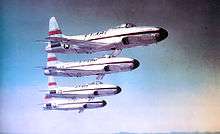Echelon formation

An echelon formation is a (usually military) formation in which its units are arranged diagonally. Each unit is stationed behind and to the right (a "right echelon"), or behind and to the left ("left echelon"), of the unit ahead. The name of the formation comes from the French word échelon, meaning a rung of a ladder, which describes the shape that this formation has when viewed from above or below.
Use of the formation dates back to ancient infantry and cavalry warfare when attempting to flank an enemy or to break one wing with overwhelming numbers. One of the earliest uses was at the Battle of Leuctra when the Thebans attacked the Spartan right with a column 48 men deep while their weaker center and right were refused. The echelon formation was also used by Hannibal at the Battle of Cannae, Alexander the Great at the Battle of Gaugamela, Frederick II of Prussia, and the Confederate army at the Battle of Gettysburg
.png)
The tactic persists up to the present day, where it is regularly employed by all branches of the modern armed forces. Tactically, echelon formations are used because of the excellent range of vision offered to each participant in the formation. In particular, it is commonly employed by armored cavalry because of the large, overlapping fields of fire that it gives to each tank in the formation, and by combat aircraft, where the close, streamlined flight formation can allow the planes to dramatically reduce fuel consumption by "surfing" the updraft created by the wingtip vortices of the aircraft ahead.

"Echeloning" is the name of a tactic in use by the United Kingdom's Armed forces, mainly the infantry. It consists of using a company to attack a set of positions. Once the first platoon in the company has reached its limit of exploitation (either ammunition has been expended, fatigue has become high, or casualties are mounting) another platoon "echelons through" it, to continue onto the next position. The tactic is similar to leapfrogging.
Echelon formations are also commonly used by civic, or riot police to move crowds either to the left or right.
Derived meanings
The name has also been adopted by the birdwatching community to describe the familiar V-shaped formations of flights of geese, ducks and other migratory birds, though this more symmetric formation is more strictly defined as a V formation.
In geology an echelon formation is a set of short linear features that overlap or are staggered in a line that runs obliquely to the strike of the individual features. Echelon faults and en echelon veins are examples.
In mathematics, the term row echelon form refers to a kind of matrix where the non-zero elements are shaped in an echelon-like manner.
In road bicycle racing, an echelon formation is a diagonal line of racers, which allows cooperative drafting in crosswinds.[1]
In sheet material response to shear stress it is typical for a series of echelon cracks to form. This is commonly seen in asphalt roads subject to shear stress imposed by aseismic fault creep.
References
- ↑ "Echelon the Crosswinds". CyclingTips. BikeExchange Pty Ltd. Retrieved 2016-07-15.